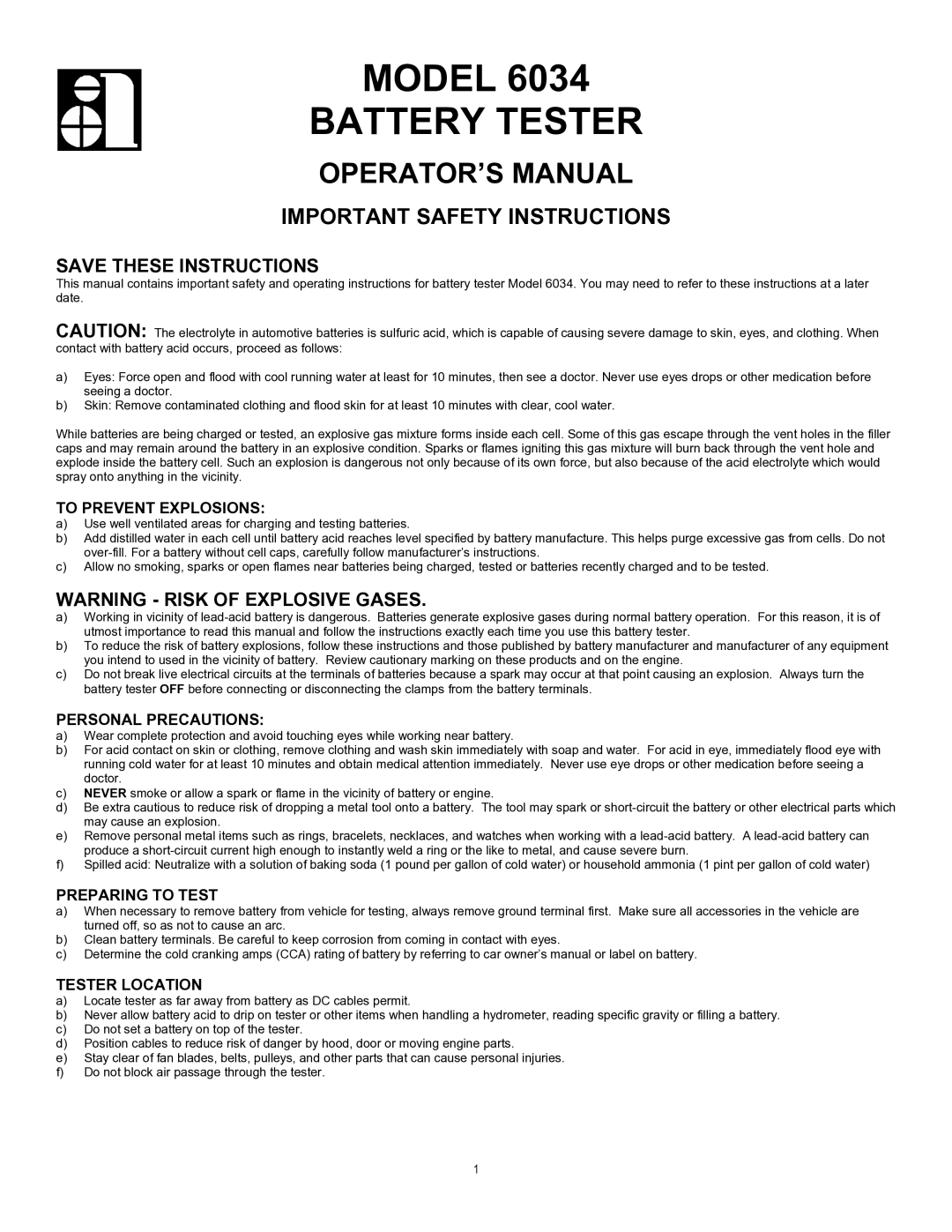
MODEL 6034
BATTERY TESTER
OPERATOR’S MANUAL
IMPORTANT SAFETY INSTRUCTIONS
SAVE THESE INSTRUCTIONS
This manual contains important safety and operating instructions for battery tester Model 6034. You may need to refer to these instructions at a later date.
CAUTION: The electrolyte in automotive batteries is sulfuric acid, which is capable of causing severe damage to skin, eyes, and clothing. When contact with battery acid occurs, proceed as follows:
a)Eyes: Force open and flood with cool running water at least for 10 minutes, then see a doctor. Never use eyes drops or other medication before seeing a doctor.
b)Skin: Remove contaminated clothing and flood skin for at least 10 minutes with clear, cool water.
While batteries are being charged or tested, an explosive gas mixture forms inside each cell. Some of this gas escape through the vent holes in the filler caps and may remain around the battery in an explosive condition. Sparks or flames igniting this gas mixture will burn back through the vent hole and explode inside the battery cell. Such an explosion is dangerous not only because of its own force, but also because of the acid electrolyte which would spray onto anything in the vicinity.
TO PREVENT EXPLOSIONS:
a)Use well ventilated areas for charging and testing batteries.
b)Add distilled water in each cell until battery acid reaches level specified by battery manufacture. This helps purge excessive gas from cells. Do not
c)Allow no smoking, sparks or open flames near batteries being charged, tested or batteries recently charged and to be tested.
WARNING - RISK OF EXPLOSIVE GASES.
a)Working in vicinity of
b)To reduce the risk of battery explosions, follow these instructions and those published by battery manufacturer and manufacturer of any equipment you intend to used in the vicinity of battery. Review cautionary marking on these products and on the engine.
c)Do not break live electrical circuits at the terminals of batteries because a spark may occur at that point causing an explosion. Always turn the battery tester OFF before connecting or disconnecting the clamps from the battery terminals.
PERSONAL PRECAUTIONS:
a)Wear complete protection and avoid touching eyes while working near battery.
b)For acid contact on skin or clothing, remove clothing and wash skin immediately with soap and water. For acid in eye, immediately flood eye with running cold water for at least 10 minutes and obtain medical attention immediately. Never use eye drops or other medication before seeing a doctor.
c)NEVER smoke or allow a spark or flame in the vicinity of battery or engine.
d)Be extra cautious to reduce risk of dropping a metal tool onto a battery. The tool may spark or
e)Remove personal metal items such as rings, bracelets, necklaces, and watches when working with a
f)Spilled acid: Neutralize with a solution of baking soda (1 pound per gallon of cold water) or household ammonia (1 pint per gallon of cold water)
PREPARING TO TEST
a)When necessary to remove battery from vehicle for testing, always remove ground terminal first. Make sure all accessories in the vehicle are turned off, so as not to cause an arc.
b)Clean battery terminals. Be careful to keep corrosion from coming in contact with eyes.
c)Determine the cold cranking amps (CCA) rating of battery by referring to car owner’s manual or label on battery.
TESTER LOCATION
a)Locate tester as far away from battery as DC cables permit.
b)Never allow battery acid to drip on tester or other items when handling a hydrometer, reading specific gravity or filling a battery.
c)Do not set a battery on top of the tester.
d)Position cables to reduce risk of danger by hood, door or moving engine parts.
e)Stay clear of fan blades, belts, pulleys, and other parts that can cause personal injuries.
f)Do not block air passage through the tester.
1
